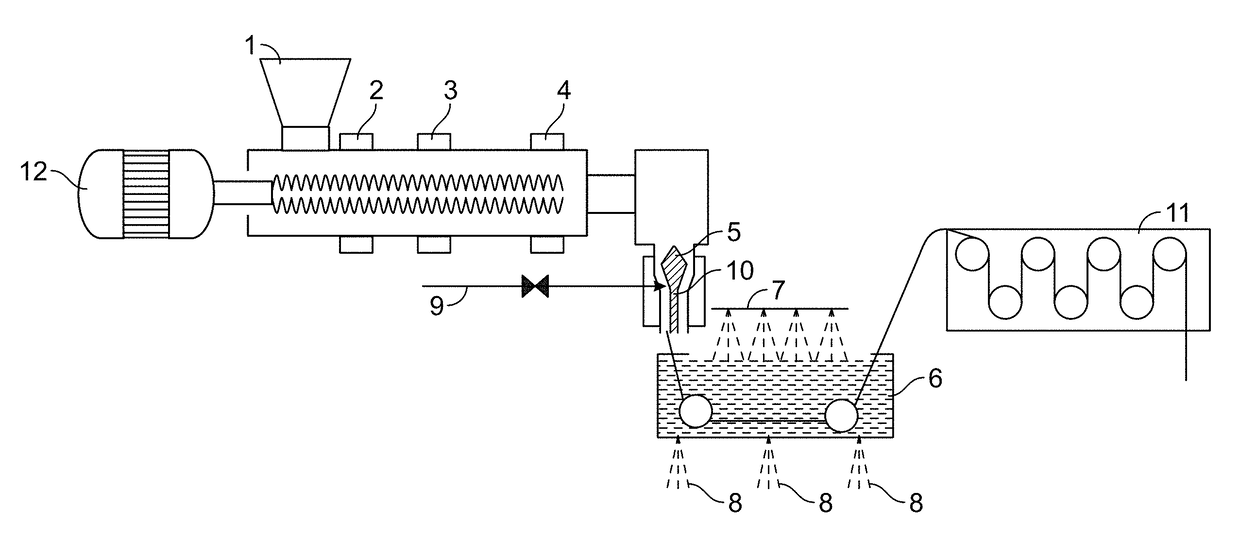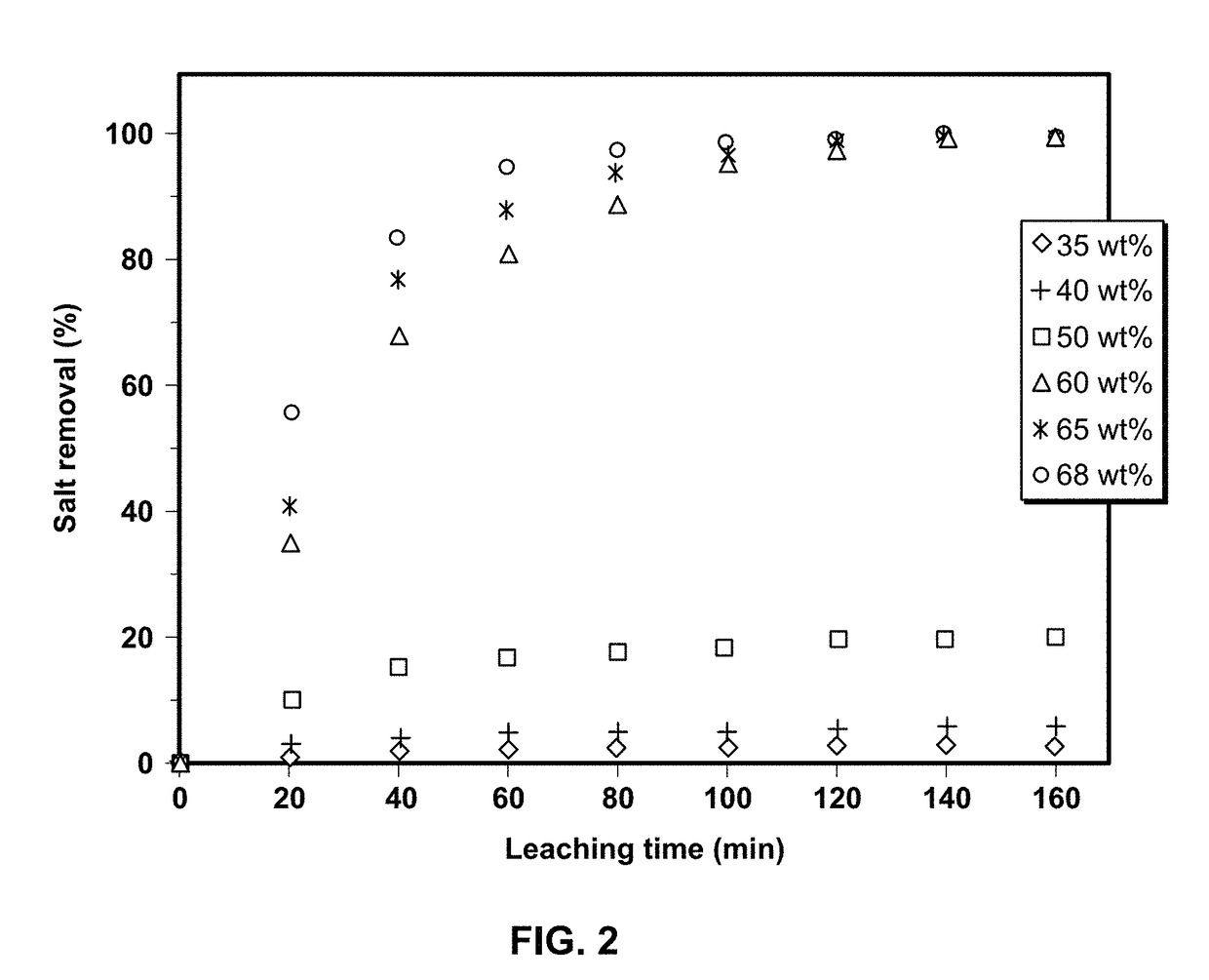Microporous and hydrophobic polymeric hollow fiber membranes and methods for preparation thereof
a polymer and hydrophobic technology, applied in the field of polymeric microporous hollow fiber membranes, can solve the problems of reduced absorption efficiency, high cost of fabrication, and wet porous polymeric membranes by liquid absorbents, and achieve the effect of diminishing membrane wettability, effective roughness on the membrane surface, and increasing initial salt conten
- Summary
- Abstract
- Description
- Claims
- Application Information
AI Technical Summary
Benefits of technology
Problems solved by technology
Method used
Image
Examples
example 1
on of LDPE Hollow Fibers
[0137]The melt-extrusion system for LDPE hollow fibers fabrication is shown in FIG. 1. LDPE hollow fiber membranes were produced using a HaakeRheomix TW-100 co-rotating twin-screw extruder. LDPE was mixed thoroughly with NaCl to form blends containing 35, 40, 50, 60, 65 and 68 wt % salt. The mixture was then fed into the extruder using the hopper (1) in two steps. In the first step, the mixture was melt blended above the melting point of LDPE to obtain a uniform polymer / salt blend. The temperature profile was controlled at 115° C. for zone 1 (2) 135° C. for zone 2 (3) and 140° C. for zone 3 (4) and the die zone, i.e. zone 4 (5). After cooling down through a water bath (6) fed by a fresh water spray (7) and emptied by salt-rich water drains (8) at room temperature, the extrudate was pelletized using a PELL 2 pelletizer supplied by Berlyn Company (not shown). In the second step, the prepared pellets were fed into the extruder using the hopper (1) at a temperatu...
example 2
of Porous Structure in LDPE Hollow Fibers
Materials and Methods
[0140]The porous structure of the LDPE hollow fibers prepared by the method of Example 1 was formed by removal of salt particles using a water leaching technique. In an exemplary preparation, 30 mmof prepared hollow fiber samples were placed in small vials, fully filled with water. The vials were sealed thoroughly and kept for 160 min in an oven at 60° C. to enhance the leaching process. Water was changed every 20 min to avoid saturation.
[0141]The percentage of salt removal was determined by comparing the dry weight of each specimen before and after leaching, using a high-resolution Mettler AE 240 digital balance. In addition, the content of salt remained in / removed from LDPE hollow fiber membranes with different initial salt content was confirmed by thermo-gravimetric analysis (TGA) of fresh fibers (before leaching) and fibers after 160 min leaching with water (after leaching), using a TA Instruments TGA model Q5000 IR f...
example 3
ngle Measurements of LDPE Hollow Fibers
Materials and Methods
[0161]The optical contact angle analyzer (OCA15 EC Plus, Dataphysics) was used to measure water contact angles of LDPE hollow fibers using the sessile drop method. The system employed a high resolution camera and specific software developed to capture and analyze the contact angle on very small and curved surfaces2. For very precise measurements, water droplets of 0.15 μl were dispensed on both inner and outer surfaces of hollow fiber samples via an ultra-thin needle with an internal diameter of 0.18 mm. For each experimental condition, measurements were performed on at least three samples and on three different portions of each sample in order to ensure the reproducibility of the results. The reported data for contact angles is the average of three obtained values.
Results and Discussion
[0162]Table 6 shows the static water contact angle of LDPE hollow fiber samples.
[0163]
TABLE 6MembraneContact angle (°)Errors (°)Blank (neat...
PUM
| Property | Measurement | Unit |
|---|---|---|
| particle size | aaaaa | aaaaa |
| porosity | aaaaa | aaaaa |
| particle size | aaaaa | aaaaa |
Abstract
Description
Claims
Application Information
 Login to View More
Login to View More - R&D
- Intellectual Property
- Life Sciences
- Materials
- Tech Scout
- Unparalleled Data Quality
- Higher Quality Content
- 60% Fewer Hallucinations
Browse by: Latest US Patents, China's latest patents, Technical Efficacy Thesaurus, Application Domain, Technology Topic, Popular Technical Reports.
© 2025 PatSnap. All rights reserved.Legal|Privacy policy|Modern Slavery Act Transparency Statement|Sitemap|About US| Contact US: help@patsnap.com



